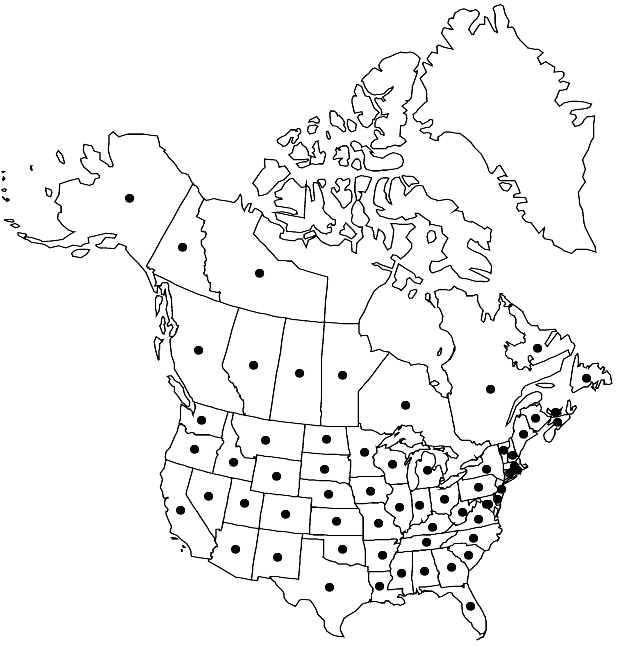Rorippa palustris
Enum. Pl., 27. 1821.
Annuals or, rarely, perennials; (short-lived, terrestrial or of wet habitat, not submerged); usually glabrous, rarely hirsute, (trichomes cylindrical). Stems (often simple from base), erect, branched distally, (0.5–) 1–10 (–14) dm, (sometimes hirsute proximally). Basal leaves rosulate; blade [(4–) 6–20 (–30) cm × 10–50 (–80) mm] margins lyrate-pinnatisect, (abaxial surface sometimes hirsute). Cauline leaves petiolate or subsessile; blade lyrate-pinnatisect, (lateral lobes oblong or ovate when present), (1.5–) 2.5–10 (–18) cm × (5–) 8–25 (–30) mm, (lateral lobes smaller than terminal), base auriculate or amplexicaul, margins subentire or irregularly dentate, sinuate, serrate, or crenate, (abaxial surface sometimes hirsute). Racemes often considerably elongated. Fruiting pedicels divaricate or slightly to strongly reflexed, straight or curved, (2.5–) 3–10 (–14) mm. Flowers: sepals erect, oblong, 1.5–2.4 (–2.6) × 0.5–1 mm; petals yellow or pale-yellow, spatulate, (1.5–) 1.8–2.5 (–3) × 0.5–1.5 (–2) mm; median filaments 1–2.5 mm; anthers ovate, 0.3–0.5 mm. Fruits usually silicles, rarely siliques, often slightly curved, oblong, ellipsoid, or oblong-ovoid, (2.5–) 4–10 × (1.5–) 1.7–3 (–3.5) mm; ovules 20–90 per ovary; style 0.2–1 (–1.2) mm. Seeds biseriate, brown to yellowish-brown, ovoid or subglobose, 0.5–0.7 (–0.9) mm (0.4–0.6 (–0.7) mm diam.), colliculate.
Distribution

Alta., B.C., Man., N.B., N.S., N.W.T., Ont., P.E.I., Que., Sask., Yukon, Ala., Alaska, Ariz., Ark., Calif., Colo., Conn., D.C., Del., Fla., Ga., Idaho, Ill., Ind., Iowa, Kans., Ky., La., Maine, Mass., Md., Mich., Minn., Miss., Mo., Mont., N.C., N.Dak., N.H., N.J., N.Mex., N.Y., Nebr., Nev., Ohio, Okla., Oreg., Pa., R.I., S.C., S.Dak., Tenn., Tex., Utah, Va., Vt., W.Va., Wash., Wis., Wyo., Europe, Asia, in n Mexico, South America, Australia
Discussion
Subspecies 2 (2 in the flora).
Rorippa palustris is a highly variable species with controversial infraspecific taxonomy. B. Jonsell (1968) recognized four subspecies, of which one (subsp. palustris) is cosmopolitan and three are North American. R. L. Stuckey (1972) followed Jonsell but further divided the North American plants into eleven, poorly defined varieties. Division of the species into subspecies based solely on stem height and fruit length is artificial. The variation is continuous in every character, and the recognized infraspecific taxa represent only some of the extremes. Some collections cannot be adequately assigned to a given subspecies or variety, and of all the infraspecific taxa recognized, only two can be consistently separated from each other; they are recognized here as subspecies.
Selected References
None.
Key
| 1 | Stems and abaxial leaf blade surfaces usually glabrous, rarely sparsely pubescent proximally. | Rorippa palustris subsp. palustris |
| 1 | Stems and abaxial leaf blades surfaces often densely hirsute. | Rorippa palustris subsp. hispida |
"elongated" is not a number."thick" is not a number."dm" is not declared as a valid unit of measurement for this property."dm" is not declared as a valid unit of measurement for this property.